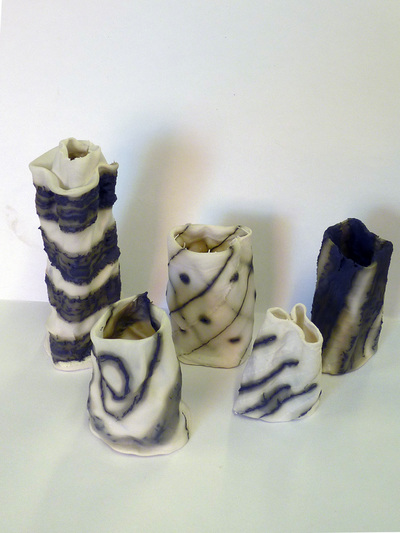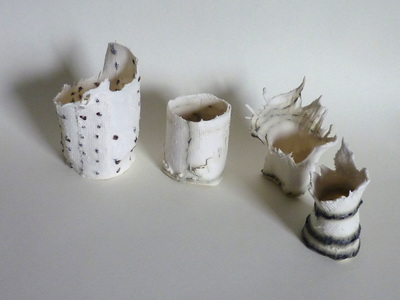Ceramics - slip-dipped, once-fired porcelain
In an experimental ceramics course at City Lit I saw a student dipping a piece of crochet into slip (liquid clay). At the time I was making "clay books" and wondered if paper book-structures, eg concertina books, could be turned into clay books. Short answer: not easily - the paper goes too floppy!
Moving ahead with the idea, I stiffened the paper with skewers and wire and with stitching before dipping. Using stitch led to using fabric, and the fabric became first "chimneys" and then actual pots (with bottoms).
The fabric is floppy too, and in addition to ways of keeping its shape when dipped into the wet clay, I've devised other techniques to keep it from collapsing during the dipping, such as letting the folds drip and dry while suspended.
The paper and fabric are burnt away in the kiln, leaving a thin layer of hard but fragile porcelain, and the wire makes black marks as it oxidises during firing. A thousand possibilities emerge....
I have made flat pieces intended as wall plaques, using gathered and heat-set synthetic organza. Pleated organza has made swirling forms. Metallic organza is used for dark areas. These fabrics have an open weave, allowing the clay to make a more solid structure. Another open-weave fabric is sinamay, which can be shaped before dipping and resiliently holds that shape.
Closely-woven fabrics can be used for double-walled structures, as can folded paper. Fabric used on the bias opens up yet more possibilities. Sinamay - a hatmaking fabric that remains rigid - is useful too!
One limitation to this process is size - all my pieces are small, rarely more than 15cm high at the moment.
Moving ahead with the idea, I stiffened the paper with skewers and wire and with stitching before dipping. Using stitch led to using fabric, and the fabric became first "chimneys" and then actual pots (with bottoms).
The fabric is floppy too, and in addition to ways of keeping its shape when dipped into the wet clay, I've devised other techniques to keep it from collapsing during the dipping, such as letting the folds drip and dry while suspended.
The paper and fabric are burnt away in the kiln, leaving a thin layer of hard but fragile porcelain, and the wire makes black marks as it oxidises during firing. A thousand possibilities emerge....
I have made flat pieces intended as wall plaques, using gathered and heat-set synthetic organza. Pleated organza has made swirling forms. Metallic organza is used for dark areas. These fabrics have an open weave, allowing the clay to make a more solid structure. Another open-weave fabric is sinamay, which can be shaped before dipping and resiliently holds that shape.
Closely-woven fabrics can be used for double-walled structures, as can folded paper. Fabric used on the bias opens up yet more possibilities. Sinamay - a hatmaking fabric that remains rigid - is useful too!
One limitation to this process is size - all my pieces are small, rarely more than 15cm high at the moment.












